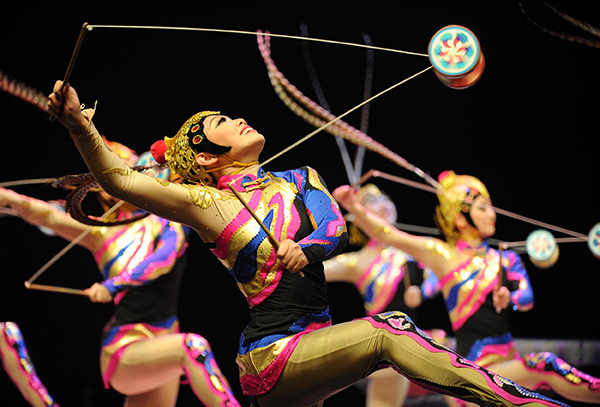Chinese acrobatics boasts a long history

Chinese acrobatics stems from people’s lives and has a close link with their daily activities and productive labor. It utilizes music, dancing, traditional operas and other art forms, providing audiences a great visual feast.
The Chinese acrobatic arts have a time-honored history.
In Chinese, acrobatics is called zaji, which refers to various skills and myriad physical and technical performing arts.
Chinese acrobatics are composed of tricks, magic, burlesque and circus performances. Based on these four fundamental skills, Chinese acrobatics is an art that requires a combination of strength and beauty.
Chinese acrobatics is rooted in the lives of the common people and has a close link with their daily activities and productive labor. The art form has evolved in tandem with the development of productivity.
The number of physical abilities and required skills has grown rapidly while the integration of music, dancing, traditional operas, art and calligraphy have diversified the types of activities contained within the art.
Chinese acrobatics can be traced back 2,000 years. It grew out of the labor and self-defense skills that people practiced and demonstrated during their leisure time, and it is regarded as a national art form today.
The evolution of Chinese acrobatic arts in ancient times underwent five stages.
Chinese acrobatics had already emerged by the time of the Neolithic age, which was regarded as the original stage of Chinese acrobatic art. It is generally acknowledged that Chinese acrobatics was derived from improvements to primitive humans’ basic skills in productive labor, martial skills and physical agility. These improvements in physical ability are believed to be the result of hunting or tribal battles.
These skills were shown in worship ceremonies, recreation and festivals and these entertainment performances gradually incubated the early acrobatic arts.
Even today and throughout history, many acrobatic performances are an artistic representation of labor and martial skills.
For instance, academics regard Boomerang as the earliest form of acrobatic performance, and today it is a standard piece in many folk activities.
The Spring and Autumn period, along with the Warring States period, are regarded as a phase when the art form underwent rapid development.
At that time, feudal kings were involved in endless disputes and the demand for talent increased. Some nobles hired talented performers as retainers, providing them stipends in exchange for their advice or martial skills. These retainers or martial masters laid the foundation for the formation of acrobatics and would eventually go on to become the creaters of acrobatic arts during this period.
The Han Dynasty was a growth stage of Chinese acrobatics. Liu Che (156-87 BCD), Emperor Wu of Han, was fond of acrobatic arts. It is recorded that Emperor Wu once held a large party with a grand acrobatic performance, and both music and dancing were incorporated into it.
After the social turmoil and the national cultural integration in the Wei, Jin, Northern and Southern dynasties, Chinese acrobatics reached maturity in the Sui Dynasty. And in the Tang Dynasty, acrobatic performances became a feast for both the court and the folk.
The Tang Dynasty was a historic period in China’s feudal society that gave birth to a prosperous economy and magnificent acrobatic arts, music and dancing.
Tang acrobatics mixed up various skills and fully showed artists’ rare talents. In addition, circus, horse dancing and magic performances were well developed during this period.
The Song, Yuan, Ming and Qing dynasties represented a flourishing stage of Chinese acrobatics. The Song Dynasty enjoyed a prosperous urban economy and the group of urban residents grew rapidly. Many stages for performances and shows, called wazi yuepeng, were built out of stones or wooden sheds at the time. These were crafted on streets or markets in prosperous cities.
Acrobatics, dancing, martial arts, storytelling, singing and various performing arts were presented on the same stages for audiences. And the Yuan Dynasty boosted art exchanges between different ethnic groups and gave birth to the Yuan genre of poetic drama. During the Ming and Qing dynasties, acrobatics, dancing and other traditional performance arts were barely seen in the courts. Acrobatics was regarded as a kitschy art. In contrast, traditional operas grew vigorously. In 1790, many opera troupes from Anhui Province moved to the capital of the Qing Dynasty, Beijing, to perform and gradually created a new opera genre—Peking Opera. Peking Opera absorbed the acrobatic fighting styles to create military shows, unlike the others, which mainly focused on singing plays. Military plays gained popularity among ordinary people and finally presented the charm of the Chinese acrobatic arts in an opera form.
